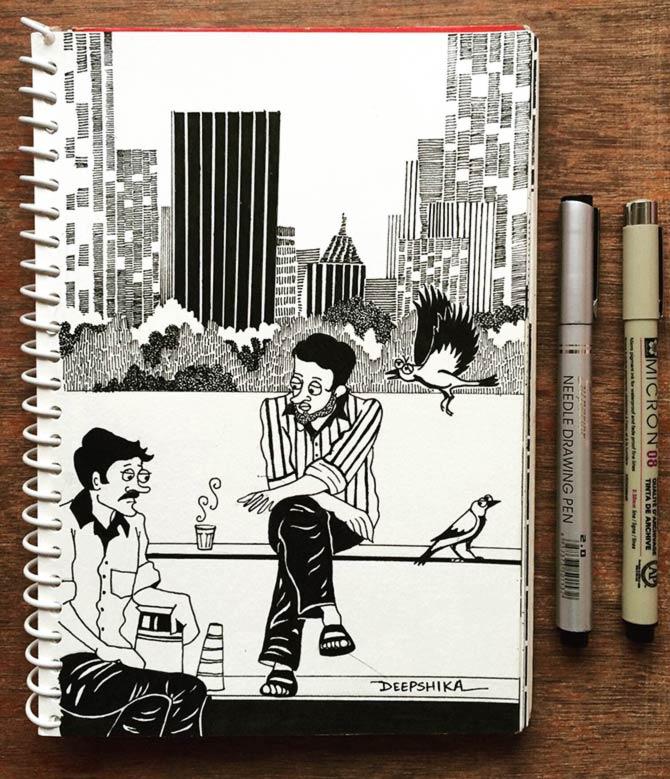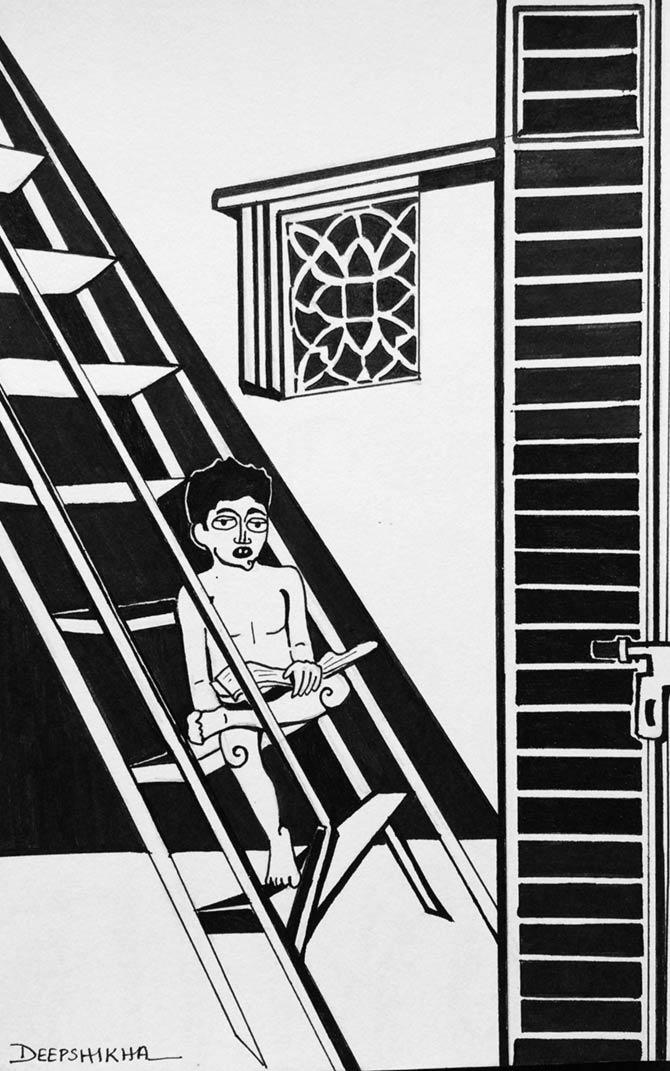What’s life like in the city of dreams?
A struggle to reach your school, college or workplace on time.
A fight to prove that you are the best and here to stay.
It’s a fast bumpy ride. Your life is so mechanical.
You visit malls, go to movie theatres, spend moolah at restaurants, take a Mumbai darshan with family and friends… but you still fail to see the city closely.
A 23-year-old girl sketches various humans of Mumbai who we often come across daily, but ignore.
Deepshikha Mondal — born and raised in Mumbai, and currently a graphic designer at Yash Raj Films — displays her artwork to Rediff.com‘s Tista Sengupta and explains what inspired her to make the sketches.
Presenting 12 of Deepshika’s sketches that perfectly describe the Maximum City.

Where did you meet her?
Earlier I used to take the local train on the Western Railway route. I spotted a young girl selling gajras.
She usually boarded the train at Bandra (northwest Mumbai) and got off at Vile Parle (three stations away, also in northwest Mumbai).
Wearing an old anarkali, she carried a plastic packet filled with flowers. Taking out a bunch of them in a small basket, she kept the rest aside.
She always had a crooked smile on her face.
What’s so special about her?
One day, I was standing near the exit listening to music and she happened to stand next to me, waiting to alight at the next station.
We looked at each other and she flashed a 100 watt smile.
This was the first time I saw her smile this way. And I remember it clearly.
There was a twinkle in her eyes. Perhaps, she may have expected me to buy her flowers. But I didn’t.
What took me by surprise is that she never forced anyone to buy the flowers.
Unlike kids selling stuff at traffic signals who keep pestering people to buy from them, this girl never annoyed anyone.
She’d just walk past those who didn’t want to buy her flowers.

What motivated you to sketch him?
I’d seen this man selling vegetables and dry fruits at Andheri market (northwest Mumbai). He was wearing a white kurta and a Gandhi cap and had a typical Maharashtrian look.
Somehow his attire reminded me of my student days, learning design at the Symbiosis Institute of Design, Pune. People in Pune are dressed this way more often than the ones in Mumbai.
Is there some message you want to share through this illustration?
Frankly speaking, I don’t know this man’s story. He must be a farmer travelling from some village to the city to sell veggies and fruits.
His thela (cart) was filled to the brim, but he had no customers.
People these days go to supermarkets, instead of local vendors. I do the same too.
But we never think that these hard-working folks may also have fresh stuff.
My father and I bought chana (chickpeas) from him and the quality was good.

What was the thought behind this one?
This illustration shows how different people commute by local trains. It’s a composition of people I have encountered.
There’s a kid having fun, hanging from the top and holding the handles, while his mother keeps a close watch on him.
In front, you will find a boy so engrossed in his music that he hasn’t noticed the thief stealing his wallet.
Don’t miss the man, standing in the centre, who has his shades on his forehead. He is dressed in a shimmery shirt with floral patterns and thinks himself to be super cool.
In Mumbai, we are so engrossed in our own worlds that we fail to notice the people around nor are we bothered about our co-passengers.

What the inspiration behind this illustration?
I saw these men while I was chilling at Marine Drive.
The culture of being friendly in Mumbai fascinates me a lot.
I have shown how a tea seller got into an intense conversation for almost an hour with one of his customers. And mind you, they were complete strangers.
For me, the chaiwallah is a social person, He loves to chat. Others may think the other man was so lonely that he ended up conversing with the tea seller.
Many times autotrickshaw drivers make random conversations about Bollywood, politics, etc while driving me to my destination.

How did you come up with this one?
I was out with my mother hunting for a maid in one of the chawls.
As I entered the narrow alley, I spotted this child sitting on a steel staircase. He was loudly reciting a Marathi poem from his school text book.
The expression on his face said he had to complete his studies. He seemed to be a diligent student.
Maybe there was no electricity in his home or there were too many people inside. So he had to sit down out on the staircase to be able to concentrate and study better.
Like this boy, there are kids in Mumbai’s slums who too want to study.
[source;rediff.com]





















